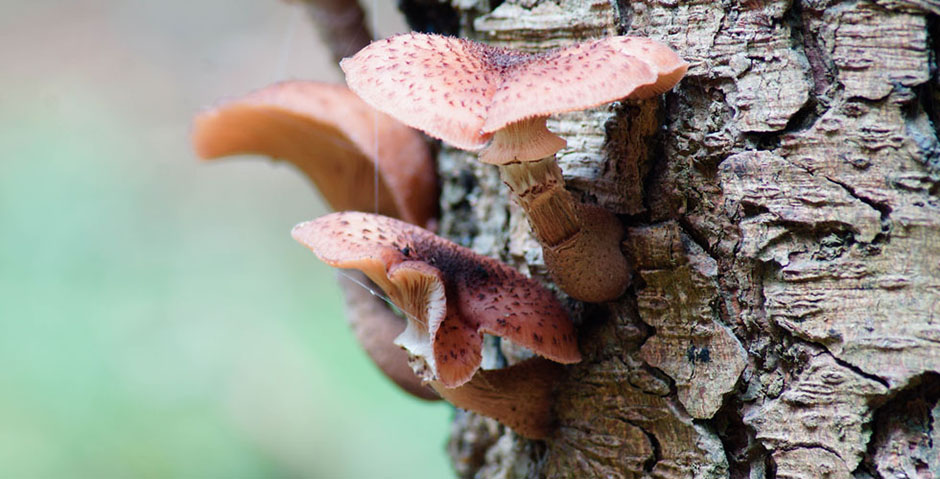Tree Fungus Treatment
If you spot a Fungus on your tree the first step is identification in order to gain understanding about the potential impact it may be having on the tree. Our Tree Fungi Guide below will help you to identify some of the most common Tree Decay Fungi in the UK.
There are many different types of Tree Fungi, which commonly take hold by penetrating through tree wounds. It is important to note that not all fungi are harmful to trees, and that any damage/decay caused may occur over a lengthy time period.
Following identification and review of tree condition, if the tree is showing signs of decline advance investigation works may be required to determine the extent of possible decay caused by the fungal pathogen.
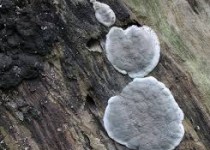
Ustulina deusta also known as Kretzschmaria deusta – ‘Brittle Cinder’
- Form: ‘Cushion’ – like fruiting body
- Fruits: Jan/ Dec.
- Area of Infection: Roots.
- Trees: Broadleaved trees including Beech, Lime, Horse Chestnut, Maple.
- Wood Decomposition: White rot.
- Other details: The fungi enters through root injuries and settles in the root. It can be very damaging to trees, weakening the wood at the base of the tree and may ultimately cause it to fail.
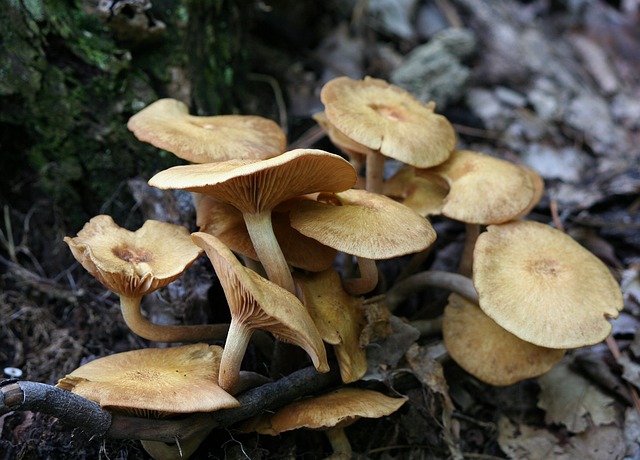
Armillaria Mellea – ‘Honey fungus/ bootlace fungus’
- Form: Convex yellow/brown fungal body
- Fruits: July/ Nov.
- Area of Infection: Roots and trunk base.
- Trees: Broadleaved trees and conifers.
- Wood Decomposition: White rot.
- Other Details: The fungus can eventually cause tree failure.
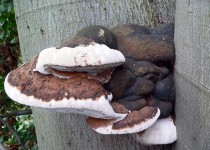
Ganoderma adspersum – ‘Southern Bracket’
- Form: Bracket fungus
- Fruits: Jan/Dec.
- Area of Infection: Roots and trunk base
- Trees: Broadleaved trees.
- Wood Decomposition: White rot.
- Other Details: The white rot this fungus causes in the roots and the trunk will make the host tree unstable, which may ultimately bringing about the demise of the tree.
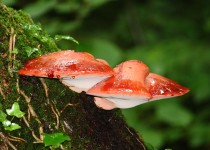
Fistulina hepatica – ‘Beefsteak Fungus’
- Form: Bracket fungus
- Fruits: June/October.
- Area of infection: Roots and trunk.
- Trees: Old Oaks, also Sweet Chestnut.
- Wood Decomposition: Brown rot/ dry rot.
- Other Details: This fungus is a weak parasite on older trees, and is responsible for the hollowing of many Oak trees.
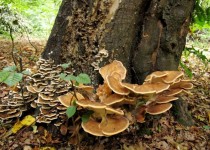
Meripilus gigantus – ‘Giant polypore’
- Form: Bracket fungus
- Fruits: June/October.
- Area of infection: Roots and trunk base.
- Trees: Broadleaved species including Beech, London Plane, Oaks, Poplar, rare in conifers.
- Wood Decomposition: White rot.
- Other Details: Weak parasite enters into the trunk damages the roots, rootstock and trunk base, which may make the tree liable to collapse or toppling.
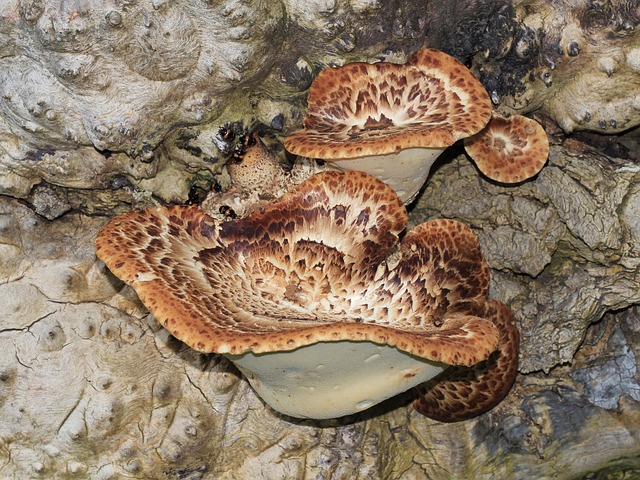
Polyporus squamosus – ‘Dryad’s Saddle’
- Form: Bracket fungus
- Fruits: April/Aug
- Area of Infection: Trunk
- Trees: Broadleaved trees including Sycamore, Beech, Willow, Poplar, Walnut.
- Wood Decomposition: White rot.
- Other Details: Enters thorugh wounds in the trunk and decomposes the heartwood.

Laetiporus Sulphureus – ‘Chicken of the Woods’
- Form: Bracket Fungus
- Fruits: May/Sept.
- Area of Infection: Trunk and crest.
- Trees: Oak, Willow, Yew, Cherry, Sweet Chestnut, rare on conifers.
- Wood Decomposition: Brown rot.
- Other Details: This is very aggressive fungus. It causes intensive brown rot in the heartwood, causing the tree to be brittle and may lead to its collapse.
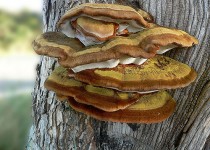
Inonotus hispidus – ‘Shaggy Bracket’
- Form: Bracket Fungus
- Fruits: June/Sept.
- Area of Infection: Trunk.
- Trees: Broadleaved trees, notably Ash, Poplar, Beech, Oak & Sycamore.
- Wood Decomposition: White rot.
- Other Details: Fruiting bodies are found on the body of the trunk. The fungus enters through wounds on the branches and trunk and decomposes the heartwood.

Ganoderma applanatum – ‘Artists Bracket’
- Form: Bracket Fungus
- Fruits: Throughout the year
- Area of Infection: Deadwood – softenswood
- Trees: Broadleaves
- Wood Decomposition: Intensive white rot.
- Other Details: The fungus may ultimately bring about the demise of the host and/or cause a brittle fracture of main trunk at point of decay.

Inonotus Dryadeus – ‘Warted Oak Polypore’/ ‘Oak Bracket’
- Form: Bracket Fungus.
- Fruits: July – October.
- Area of Infection: White rot of stem butt and roots.
- Trees: Predominantly Oak species, less commonly found on other broadleaved including Sycamore, Beech, Elm and Ash.
- Wood Decomposition: Heartwood.
- Other Details: The rot affects the underside of roots and root buttresses, and when the tree is in advance stages of decay it may fail.
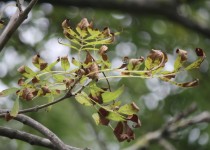
Hymenoscyphus fraxineus – Chalara Dieback of Ash
- Form: Fungal spores.
- Fruits: N/A.
- Area of Infection: Bark, girdling twigs and branches and fallen leaves.
- Trees: Ash.
- Wood Decomposition: The fungus causes leaf loss, crown dieback and bark lesions.
- Other Details: Little is known about this fungus. Once a tree is infected with the disease, it is usually fatal. This is a fungus which attacks in two phases, according to its life cycle.
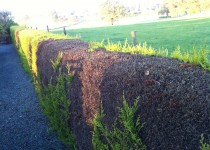
Cinara cupressivora – Cypress Aphid
- Form: Aphid (blackish brown sap-sucking) insect.
- Fruits: N/A.
- Area of Infection: Stem.
- Trees: Hedging conifers (Cupressus species especially C. macrocarpa, Thuja occidentalis, Chamaecyparis lawsoniana and x Cuprocyparis leylandii)
- Wood Decomposition: Causes a gradual drying up of the foliage.
- Other Details: The aphid is most active in June – April. Symptoms include yellowing shoots in summer, by late summer many of these will be brown and dead, a black powdery coating of sooty mould may develop on the stems and foliage. It is possible that damaged hedges may recover, but this is likely to be a slow process.
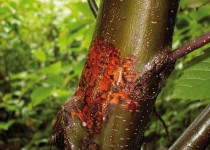
Cryphonectria parasitica – Chestnut Blight
- Form: Fungal spores.
- Fruits: N/A.
- Area of Infection: Foliage, stems.
- Trees: Sweet Chestnut.
- Wood Decomposition: Foliage wilts and dies due to cankers.
- Other Details: The infection is usually fatal in Sweet Chestnut trees. Note: Horse Chestnut trees (Aesculus hippocastanum) are not affected. Typical symptoms include: foliage wilts and dies as a result of girdling cankers lower down the stem and diseased orange bark on young stems. Cankers develop on the stems on which masses of yellow-orange to reddish-brown pustules, the size of a pin-head (fruiting bodies) are visible. Cankers can spread throughout the tree surface, killing the tree. Although young trees may succumb to the disease within a year, it may take years before mature trees eventually die. The root system is not affected.

Ophiostoma novo ulmi – Dutch Elm Disease (DED)
- Form: Spread by Elm bark beetles.
- Fruits: N/A.
- Area of Infection: Fungus blocks the vasular (water transport) system.
- Trees: Elm.
- Wood Decomposition: It is a type of disease known as a vascular wilt, causing the branches to wilt and die.
- Other Details: This is a serious disease of Elm trees. Damage is usually seen in summer and early autumn. Symptoms include: foliage turning yellow, then wilts, shrivels and dies. Peeling off the bark from affected branches will reveal brown streaks in the outer wood, which appear as a broken or continuous brown ring in the outer growth ring if the branch is cut across.
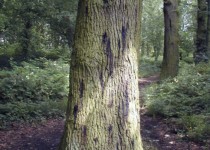
Oak Decline (Chronic and Acute)
- Description: Oak Decline is a term that describes the deterioration of Oak trees, in some cases eventually leading to death of the tree. In recent years another problem called Acute Oak Decline, which is caused by a bacterial pathogen, has been affecting an increasing number of trees, and can lead to a rapid deterioration of affected trees. Note: Oak Decline is unrelated to the disease known as Sudden Oak Death which, despite its name, does not notably affect English Oak trees.
- Chronic Oak Decline: Mainly affects Pedunculate Oak (Quercus robur). It is a progressive deterioration of the crown, taking many years. Symptoms include leaves becoming paler and smaller, dieback of twigs and branches. In severe cases the tree may fail.
- Acute Oak Decline: Affects mature (greater than 50 years old) trees of Pedunculate Oak, Sessile Oak (Quercus petraea) and hybrids between the two. A dark fluid weeps down the trunk from cracks (about 5-10cm long) in the bark. This may stop and dry out at certain times of year, and can be washed off by heavy rain. Multiple bleeding patches may be present, from close to ground level to high in the canopy. Unlike Chronic Oak Decline, symptoms of deterioration in the crown may not appear until just before the tree dies.

